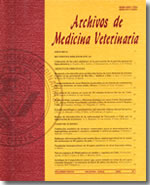Bacterial contamination in platelet concentrates of horses
Main Article Content
Abstract
The aims of the study were to: 1) assess the risk of bacterial contamination in equine platelet concentrates (PCs) obtained by the tube method under three technical conditions (laminar flow cabinet or in a clean laboratory environment both with burner and without burner) 2) identify the critical points of the process of PCs preparation with risk of bacterial contamination; and 3) identify the potential bacterial contaminants in the process. Bacteriological samples were taken from the skin (shaved or unshaved) of the venipuncture site in 15 horses, both before and after being disinfected; hands and throat of the operator; caps of the tubes where the blood was processed; environment where the equine blood samples were collected; laboratory environment; laminar flow cabinet; bacteriological stove; and PCs obtained under 3 technical conditions. Bacteria were isolated from non-aseptically prepared equine skin, hands and throat of the operator, and the place where the blood samples were taken. Bacteria were not isolated from tube caps, laboratory environment, laminar flow cabinet, or PCs. The isolated bacteria were normal biota from equine skin, human skin and throat, and environmental contaminants. Uncontaminated PCs can be obtained by the tube method in a clean laboratory environment.

